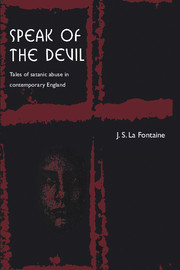Book contents
- Frontmatter
- Contents
- List of tables
- Acknowledgements
- 1 Introduction: the problem
- 2 The personification of evil
- 3 Witches, satanists and the occult
- 4 The extent of the allegations
- 5 The question of proof
- 6 Explaining belief
- 7 Children's stories
- 8 Confessions and tales of horror
- 9 A modern movement of witch-finders?
- 10 Aftermath and conclusions
- Notes
- Bibliography
- Index
4 - The extent of the allegations
Published online by Cambridge University Press: 05 June 2012
- Frontmatter
- Contents
- List of tables
- Acknowledgements
- 1 Introduction: the problem
- 2 The personification of evil
- 3 Witches, satanists and the occult
- 4 The extent of the allegations
- 5 The question of proof
- 6 Explaining belief
- 7 Children's stories
- 8 Confessions and tales of horror
- 9 A modern movement of witch-finders?
- 10 Aftermath and conclusions
- Notes
- Bibliography
- Index
Summary
The origins of the allegations
Allegations of satanic abuse began in north America with the claims made by adults, not children. The most publicised is the case of Michelle Smith. Two Canadians, Michelle Smith and her psychiatrist Lawrence Pazder, whom she subsequently married, published an account of her treatment in 1980. Under a form of hypnosis she had relived her experiences of the abuse in a satanic cult that she had suffered as a five-year-old. The book, Michelle Remembers, has had a powerful influence throughout north America and in this country. It was followed in the United States by the book by Lauren Stratford for which it may have served as a model. (The second book, Satan's Underground, has already been mentioned as an acknowledged fiction.) The first case of allegations involving children in north America concerned the McMartin nursery school in California in 1984. There is some indication that Lauren Stratford was consulted by some of the parents of children there and that adult women's stories also influenced the case (Nathan 1991: 82; Nathan & Snedeker 1995). Thereafter there were many other cases; by 1986 Finkelhor and his associates could identify ‘at least 36 cases’ where allegations of ritual abuse in nursery schools had been made (Finkelhor, Williams and Burns 1988: 59).
The background in Britain
In Britain at this time it was being demonstrated, often by widely publicised cases, that children, even very young children, might be physically and sexually abused by the adults who had care of them.
- Type
- Chapter
- Information
- Speak of the DevilTales of Satanic Abuse in Contemporary England, pp. 56 - 75Publisher: Cambridge University PressPrint publication year: 1998

